News:
A Landmark Kandinsky With a Troubled Past Is in the Spotlight, Again
By Nina Siegal
Reporting from Amsterdam
The abstract work was looted by the Nazis, displayed in a Dutch museum and finally returned to its owners. It’s now the star piece at this year’s TEFAF.
“Blick auf Murnau mit Kirche II,” (“View of Murnau with Church 2”) (1910) sold at auction a year ago for $45 million. The dealer who bought the painting decided to bring it to TEFAF
Murnau, a village in the Bavarian Alps, is often recognized as the place where Wassily Kandinsky discovered abstraction.
While living there with his girlfriend, the artist Gabriele Münter, he came home in twilight to see one of his own paintings on its side. He realized it was not representation that mattered, but what he called the “spiritual,” as expressed in color, shape and form.
One landscape that reflected his new thinking was “Blick auf Murnau mit Kirche II,” (“View of Murnau with Church 2”) (1910).
Not everyone loved abstraction then, but Siegbert Samuel Stern, a women’s garment manufacturer, and his wife, Johanna Margarethe, bought the piece in 1924 and hung it in their mansion, in Babelsberg, Germany.
A family photo of the Sterns and their four children shows the canvas above the dining room table, where other guests apparently included Franz Kafka and Albert Einstein. The couple also showcased their collection of old master paintings, Han dynasty Chinese ceramics and work by van Gogh and Rodin.
When Mr. Stern died in 1935, he had collected 144 works. Ms. Stern, a widow, found herself alone in Nazi Germany at a time when Jews and abstract artists were targets of the Reich.
In 1937, the Nazi leadership demanded 57 of Kandinsky’s artworks be removed from the nation’s museums as part of an effort to root out so-called degenerate art.
Ms. Stern moved to the Netherlands in 1939, to join her children, who had already fled there. The Germans invaded the Netherlands a year later, and after four years in hiding, she was discovered and deported to Auschwitz, where she was killed in 1944.
As to what happened to the painting during the war, it is not entirely clear. It ended up in the hands of National Socialists in 1938, and then with a Berlin dealer until 1943. An Austrian art dealer based in The Hague sold the painting to the Van Abbemuseum in Eindhoven, the Netherlands, in 1951, and it remained there for 70 years.
Ms. Stern’s heirs first made a claim on the painting to the Restitutions Committee in the Netherlands in 2016. After that request was rejected in 2018 for “insufficient facts,” the same committee reversed its decision and recommended restitution in 2022. The 13 heirs decided to sell the work and divide the proceeds. It was put up for sale at Sotheby’s about a year ago and sold for about $45 million.
The art dealer Robert Landau, who told The New York Times that he had agreed to buy the painting (for a “minimum guarantee”) from Sotheby’s before the sale, was not outbid.
It was sent to his home in Switzerland in December, where he got to view it in person for the first time. “It gets better as each day goes on,” he said. “When you first see it you’ll love it, but then you get tied up emotionally with the painting.”
Mr. Landau said he’d invested about $50 million total in the painting. He will ask for more than that at TEFAF, he said, but the ultimate sales price will depend on the buyer.
“If it’s a client of mine who I know and who I know will care for it, we will not be greedy,” said Mr. Landau in an interview. “It’s a world class painting, it’s the most expensive Kandinsky that’s ever sold at public auction, it’s in perfect condition, and it’s a pivotal painting in the history of abstract art. I can’t put a value on it. We won’t know the price until it happens.”


